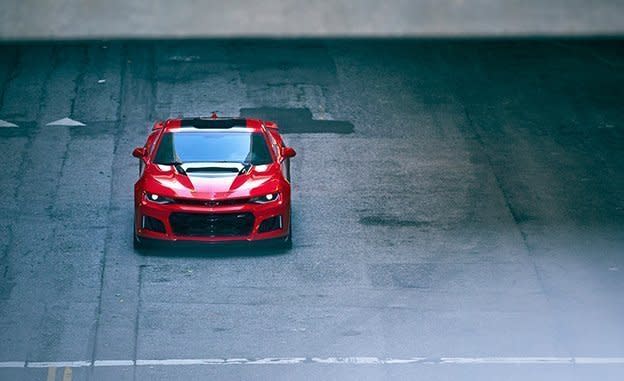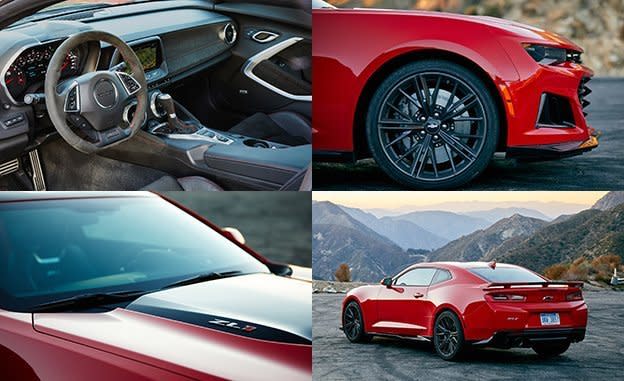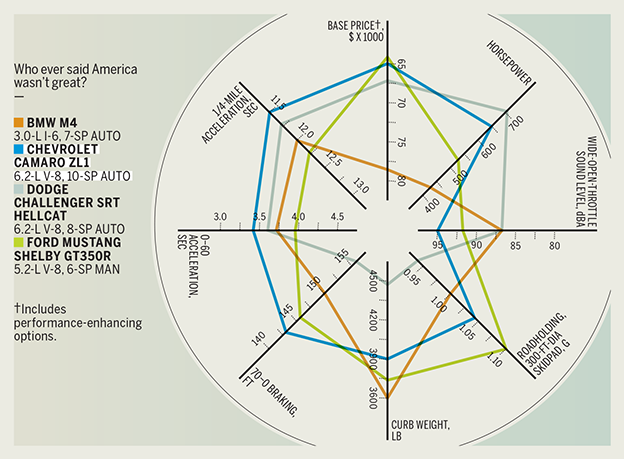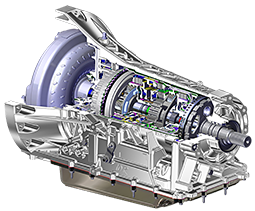2017 Chevrolet Camaro ZL1

From the March 2017 issue
It’s a curious truth of automotive engineering that, in general, the lower the volume target for a new vehicle, the more effort is invested in perfecting it. Engineers seem to sweat the nuances of a Ferrari far more than they do those of a Fiat. The same goes for performance models of mass-produced vehicles. With the tedious stuff already taken care of—say, making the car come together as easily as a SnapTite model on the assembly line—the performance guys are free to spend months toying with bushing stiffness. Unburdened by trivialities such as radio reception or defroster performance, the go-fast department finds time to lap a track for 24 hours.
Such is the back story of the Chevrolet Camaro ZL1. Development engineers fussed over seven iterations of their customized Goodyear Eagle F1 Supercar 3 tires (three iterations are typical in vehicle development). They spent more than a year calibrating the 10-speed automatic transmission. And they made six separate trips to the Nürburgring in order to fine-tune the car, with the eventual payoff being a 7:29.60 lap, almost 12 seconds faster than its predecessor.

That exhaustive development was applied to some of the most astonishing hardware extant. Its magnetorheological dampers take their cues from sensors that read the road 1000 times per second; an electronically controlled limited-slip differential shuffles torque between the rear wheels with computer precision; and a wet-sump variant of the LT4 supercharged 6.2-liter V-8 delivers incredible thrust. Imagine a Dodge Challenger SRT Hellcat that can corner, a Ford Mustang Shelby GT350 with an additional 124 horsepower, and a BMW M4 with even better steering. The Camaro ZL1 is all of these things and more.
The ZL1’s parts list is familiar. Many will think of this car as a Corvette Z06 with four seats, its base price of $63,435 equating to a $17,010 discount over the super-Vette. But the ZL1 is not exactly a Z06, even if bits of it certainly are shared. The ZL1’s own contribution to Chevy’s arsenal of performance parts is its new 10-speed automatic transmission [see “Explained” below]. The standard six-speed manual gearbox, with a well-weighted shifter and clutch pedal, is a much better choice for those who want to choose their own gears, but the auto is a ’box of magic.
It allows a dramatic windup through first, then supplies a progression of rapid-fire rpm rewinds as you rocket to triple-digit speeds, the gearbox racing through upshifts with superbike-like snappiness. In Los Angeles traffic, conversely, the transmission picked through the ratios with virtually imperceptible gearchanges. At any pace, it shifts with minimal torque reduction and never hunts for the right ratio. When you demand thrust, the trans executes a sudden yet smooth downshift without any intermediate steps. Mat the throttle from 60 mph and a flawless tenth-to-third transition wakes the LT4 like a sleeping lion poked with a branding iron.
Consider the ZL1’s 50-to-70-mph passing performance, a test we initiate once the transmission has selected its highest ratio as the car lopes along at 50 mph. At 2.1 seconds, the ZL1’s surge is just 0.3 second behind that of the 532-hp Tesla Model S P90D, which doesn’t need to shift its single-speed gearbox.

It might look like a brute, but with an eLSD, communicative steering, and perfectly judged suspension tuning, the ZL1 moves with genuine grace.
The team that built the ZL1 pitches the car as equally adept at running quarter-mile drags, lapping Virginia International Raceway, and writhing along the Angeles Crest Highway. It’s certainly competent at any of those activities, but we think it’s truly exceptional at the last one, streaking down a great road and plastering a grin on your face. Strapped into the deeply bolstered Recaros by red seatbelts (standard with select exterior colors), we hammered the ZL1 over the highway through the San Gabriel Mountains north of Los Angeles, confident in its firm brake pedal and natural steering, the trans automatically holding the lowest gear, and the engine blasting anger through the valleys. Few things have made us happier this year.
We weren’t offered a chance to drive the ZL1 convertible, so we can’t say if Chevy has done anything to stiffen that rolling tub of Jell-O. The coupe, however, has no trouble managing the engine’s grunt, the road’s imperfections, and the considerable cornering forces the ZL1 can muster.
With the Camaro ZL1, Chevrolet mixes its most raucous, most capable hardware into a monster of a car at a bargain price. More tire and less weight could turn it into a true track rat, but it’s a car that you can live with every day and hustle across any piece of pavement, and we wouldn’t change a thing. The ZL1 is even greater than the sum of its special parts.
Competitors


Explained: Hydra-Matic 10R90 Automatic Transmission
The 10-speed automatics in the Ford F-150 Raptor and the Camaro ZL1 originate from the same base gearbox, the product of a collaboration between the two American automakers. While Ford led the development of the 10R transmission, GM engineers refined the Hydra-Matic 10R90 for use in the company’s high-output powertrains. Hydra-Matic–specific pieces include the torque converter, clutch components, planetary gear carriers, and bearing supports, all uprated to cope with the LT4 V-8’s 650 pound-feet of torque.
All 10R transmissions get their 10 ratios from four planetary gearsets selectively controlled with six clutches—four that rotate and two that act as brakes. The transmission case slips into the same space as GM’s longitudinal eight-speed, which fits into the same space as the six-speed before it.
You might expect the industry’s first 10-speed transmission to boast a gaping overall ratio spread, but the 10R’s 7.38:1 range is far from the widest in the business. Among longitudinal automatic transmissions, that spread is topped by ZF’s second-generation eight-speed 8HP, and both seven- and eight-speed versions of Porsche’s PDK for front-engine vehicles, the latter of which has a yawning 11.26:1 spread.
Engineers say there’d be little benefit to stretching the ratio spread given the 10R’s intended applications. The ZL1 lights up its tires at less than full throttle in first gear, and the LT4 turns over at less than 1900 rpm in 10th gear at 80 mph. Instead, the 10R packs its ratios closer together, with upshifts averaging a 19 percent drop in rpm versus 29 percent in the eight-cog PDK. That keeps the engine closer to its power peak throughout full-throttle acceleration runs, and this keeps us happy.Specifications >
VEHICLE TYPE: front-engine, rear-wheel-drive, 4-passenger, 2-door coupe
PRICE AS TESTED: $67,000* (base price: $63,435)
ENGINE TYPE: supercharged and intercooled pushrod 16-valve V-8, aluminum block and heads, direct fuel injection
Displacement: 376 cu in, 6162 cc
Power: 650 hp @ 6400 rpm
Torque: 650 lb-ft @ 3600 rpm
TRANSMISSION: 10-speed automatic with manual shifting mode
DIMENSIONS:
Wheelbase: 110.7 in
Length: 188.3 in
Width: 74.7 in Height: 52.4 in
SAE volume: F: 54 cu ft R: 31 cu ft
Trunk volume: 9 cu ft
Curb weight: 3933 lb
C/D TEST RESULTS:
Zero to 60 mph: 3.4 sec
Zero to 100 mph: 7.4 sec
Zero to 150 mph: 18.4 sec
Rolling start, 5–60 mph: 3.9 sec
Top gear, 30–50 mph: 1.8 sec
Top gear, 50–70 mph: 2.1 sec
Standing ¼-mile: 11.5 sec @ 125 mph
Top speed (drag ltd, C/D est): 195 mph
Braking, 70–0 mph: 143 ft
Roadholding, 300-ft-dia skidpad: 1.04 g
FUEL ECONOMY:
EPA combined/city/hwy (C/D est): 18/15/22 mpg
C/D observed: 13 mpg
* C/D est.

 Yahoo Autos
Yahoo Autos 